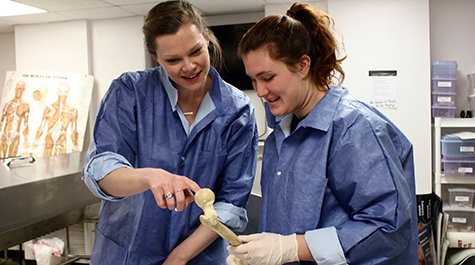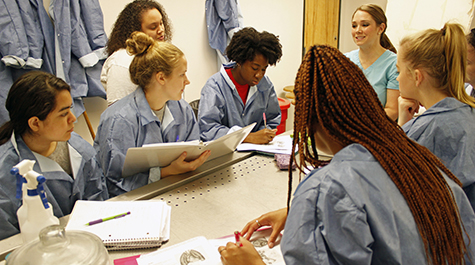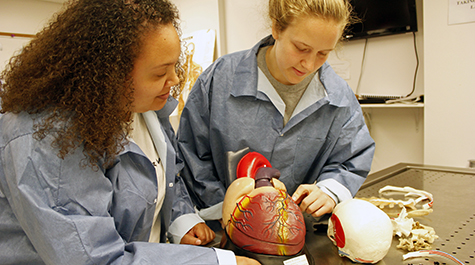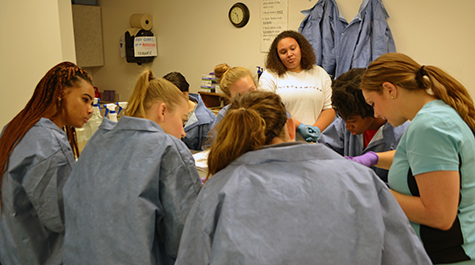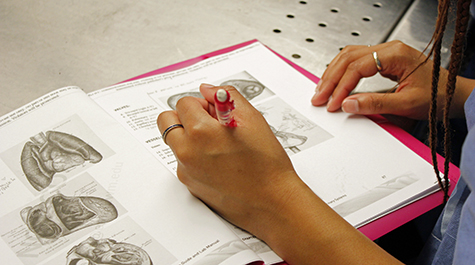A human approach to human anatomy
Anderson ‘18 is in her second year of occupational therapy school at Virginia Commonwealth University. She plans to become an occupational therapist to “get people back to doing what they need to do in their daily lives.”
She credits her entire career to a course mix-up at William & Mary, which eventually led her to enroll in Human Anatomy Lab, a class that for over 50 years has allowed undergraduate students to gain an understanding of anatomy using actual human cadavers.
“The course literally changed my life,” Anderson said. “I didn’t want to be a science person at all, but I entered the wrong course number and wound up taking Intro to the Human Body and then the Anatomy Lab. It was awe-inspiring seeing how the body worked and, even more inspiring, there were people who provided their bodies so students like me could learn from them. The simplest way to put it is, I wouldn’t be where I am without those people and without that course.”
Every year, roughly 160 students at William & Mary take the Anatomy Lab and gain firsthand dissection experience, says Evie Burnet, lecturer in the Department of Kinesiology & Health Sciences.
According to the Virginia State Anatomical Program, the organization that regulates the distribution of cadavers, William & Mary has historically been one of the few undergraduate institutions in Virginia to offer cadaveric dissection and the department is home to one of the oldest programs in the state.
“As a physical therapist, I work with human beings,” said Burnet, who has taught the lab for 13 years. “I don’t work with cats and I don’t work in virtual reality. Without seeing an actual human body, our students really cannot appreciate the three-dimensional arrangement of its structures. You have to be able to visualize the orientation of muscles and their fibers, organs, nerves and vessels in order to fully understand how it all works together. Nothing else comes anywhere close to doing this for you.”
On a recent Tuesday, seven undergrads huddled around a steel dissection table as their lab instructor Ashleigh Everhardt Queen discussed matters of the heart.
“Here we go. Coronary vessels, these are the vessels of the heart,” Queen said, probing the human heart with a gloved hand and a scalpel. “The heart is a selfish organ, remember that. It is going to take its blood first. It also does more work than any other muscle in your body, so that makes sense.”
Queen opened the heart to reveal a vast array of structures. For most students, it was the first time they had seen the inner workings of an actual human heart. For Brooke Ford ‘21, it was just part of the job.
Ford is the lab’s undergraduate teaching assistant this summer. In an effort to give students more experience with cadavers, each semester the faculty select one or two high-achieving students to mentor their fellow undergraduates in each lab section. This summer session is Ford’s third time serving as TA in the lab.
“This lab is the reason I decided to go to William & Mary,” Ford said. “It has one of the only programs where they allow students to dissect, not just view the body, but actually dissect. It’s important for me to know what’s going on in these structures, what’s happening during processes. I need to see it firsthand.”
When she says she needs firsthand experience, Ford means it. She works the night shift in the emergency room at Mary Immaculate Hospital in Newport News. She is an ER scribe, meaning she takes notes for doctors. Correctly recording an injury and knowing the exact location of where that injury occurred is a vital part of her profession.
“I work really closely with the doctors, so I get to see their thought process,” Ford said. “They will pull up an X-ray and say ‘well, the calcaneus bone here is broken,’ and I’ll know exactly where that is because I’ve had this class.”
It’s that direct connection, from class to life, that students emphasize as a valuable part of the experience. Katie Pacak ’20 took the lab for the first time this summer as she prepares to join the Tribe football team as a student athletic trainer in the fall.
“This whole experience has been incredible,” Pacak said. “I see people in the gym and I can visualize all the muscles they’re using. Seeing as I’m going to be working with student athletes, learning the muscular system in this way will be beneficial. I’ll be applying everything I’ve learned.”
Two bodies are provided to the lab during the fall and spring semesters. The summer lab dissects only one. During the regular school year, students have the option of actively dissecting during the lab or viewing the dissection. This allows students to feel comfortable being as hands-on or hands-off as they’d like, says Ray McCoy, associate professor of kinesiology and health sciences.
McCoy has spent the past 31 years teaching anatomy at William & Mary. His vast amount of dissection experience is evident in the way he explains even the most fundamental human structures.
“If you ever pull on an artery, it stretches in this almost springy way,” he said. “You realize that’s definitely an artery. You have to know what that feels like, which is why we teach with actual cadavers.”
But teaching undergraduates to work with cadavers comes with a special set of considerations, Queen said. The faculty must account for the emotional toll the process can take on students, many of whom have never seen a dead body. Unlike graduate school anatomy courses, students do not dissect the face. They are given no personal details about the individual.
“We share very little about the person with the students,” Queen said. “And we also strategically decide which parts of the body to dissect first, starting with the less personal areas like the lower extremities and working our way up to something personal like the hands.”
Queen and her colleagues should know about the unique aspects of teaching cadaveric dissection to undergrads. They literally wrote the book on it. The book, “Human Anatomy Dissection Guide and Lab Manual,” was published last year and replicates the curriculum taught in the lab.
“We’re excited about the lab book because it’s something I’ve been teaching, the same words and structures, for years and years,” McCoy said. “I used to copy it at the copy center and give it to students, but now we have one that’s actually published.”
Queen stresses that the book is designed for students who walk into the lab never having done any kind of dissection before. At William & Mary, that is often the case. The course has never been major-locked, meaning that it’s open to anyone with an interest.
“We’ve had art majors who want to understand the human body to better do whichever medium of art they specialize in,” Burnet said. “I had a student in the fall who was a business major. He just thought the class sounded unique and he was an amazing student. I actually asked him if he was sure he wanted to do business, because I thought medicine was his calling. He stayed with business, but that just shows the variety of students who learn from this experience.”
 Skip to main content
Skip to main content

